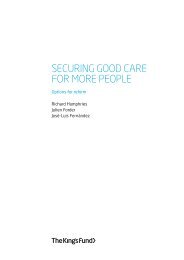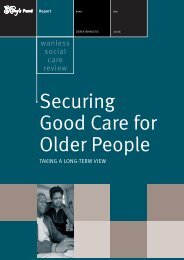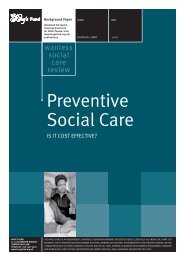Time and other inputs for high quality social care - The King's Fund
Time and other inputs for high quality social care - The King's Fund
Time and other inputs for high quality social care - The King's Fund
You also want an ePaper? Increase the reach of your titles
YUMPU automatically turns print PDFs into web optimized ePapers that Google loves.
Inputs <strong>for</strong> ‘<strong>quality</strong>’ home-based<br />
<strong>social</strong> <strong>care</strong><br />
Following the literature review, two tables were constructed. <strong>The</strong> first (Table 1, see<br />
pp 13–16) describes 24 different scenarios that are intended to reflect the progression of<br />
ADL loss among older people with physical disability <strong>and</strong>/or cognitive impairment at<br />
increasing degrees of severity, whereby the first ADLs to be lost are dressing <strong>and</strong> personal<br />
hygiene, <strong>and</strong> the last ADLs to be lost are bed mobility <strong>and</strong> eating (Morris et al 1999).<br />
<strong>The</strong> second table (Table 2, see pp 17–20) suggests the appropriate amount of <strong>quality</strong><br />
home-based <strong>care</strong> <strong>for</strong> each of the 24 scenarios given in Table 1. It is based on in<strong>for</strong>mation<br />
from three sources: the literature review above; literature relating resource use to<br />
behavioural problems of service users; <strong>and</strong> the professional experience of the author. 2<br />
<strong>The</strong> scenarios in Tables 1 <strong>and</strong> 2 are organised in terms of the degree of physical<br />
dependency <strong>and</strong> cognitive impairment. <strong>The</strong>y are grouped according to six categories of<br />
dependency <strong>and</strong> four categories of cognitive impairment. <strong>The</strong> six categories of dependency<br />
reflect:<br />
• a need <strong>for</strong> help in five or more PADLs including all transfers (the inability to transfer<br />
represents a breakpoint in the range of <strong>care</strong> required, substantially increasing the time<br />
required to provide <strong>care</strong> <strong>and</strong> possibly the number of <strong>care</strong>rs needed)<br />
• a need <strong>for</strong> help in five or more ADLs, not including chair, bed <strong>and</strong> toilet or commode<br />
transfers<br />
• a need <strong>for</strong> help in two to four ADLs, not including chair, bed <strong>and</strong> toilet transfers<br />
• a need <strong>for</strong> help in one PADL as well as bathing<br />
• a need <strong>for</strong> help in one PADL or bathing<br />
• no PADL dependency/help with IADLs only.<br />
<strong>The</strong> four categories of cognitive impairment are:<br />
• no cognitive impairment<br />
• mild cognitive impairment<br />
• severe cognitive impairment<br />
• severe cognitive impairment with risk factors present.<br />
<strong>The</strong> reason <strong>for</strong> distinguishing between severe cognitive impairment <strong>and</strong> severe cognitive<br />
impairment with risk factors present is that in the professional experience of the author,<br />
the presence or absence of behaviour-related risk factors is an important determinant of<br />
need <strong>for</strong> 24-hour supervision <strong>and</strong> there<strong>for</strong>e resource use.<br />
<strong>The</strong> literature suggests that people with cognitive impairment are at greater risk of<br />
institutionalisation than those without cognitive impairment (Kavanagh <strong>and</strong> Knapp 1999),<br />
but there appears to be mixed evidence on the role played by behavioural problems <strong>and</strong><br />
risk behaviours associated with cognitive impairment in increasing resource use within<br />
INPUTS FOR ‘QUALITY’ HOME-BASED SOCIAL CARE 11
















